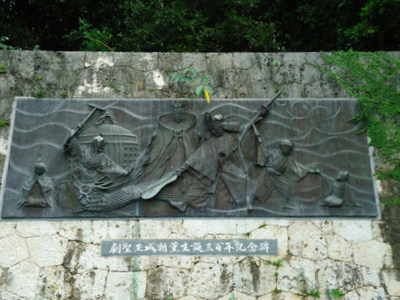
- Born: 1684/8/2
- Died: 1734/1/26
- Titles: 踊奉行 (udui bujô, Magistrate of Dance)
- Other Names: 向受佑 (Shou Juyuu)
- Japanese/Okinawan: 玉城 朝薫 (Tamagusuku Choukun)
Tamagusuku Chôkun was a Ryukyuan aristocrat-bureaucrat credited with the creation of the Ryukyuan dance-drama form known as kumi odori (O: kumi udui).
Chôkun was born in what is today the Gibo neighborhood of Shuri[1]. A member of the aristocrat-bureaucrat class of the Kingdom of the Ryûkyû, Chôkun was named sô-jitô of Tamagusuku magiri in 1692. He traveled to Kagoshima for the first time in 1704, and again in 1706 as a page (koshô, a musician and/or dancer) within a mission led by Prince Goeku congratulating Shimazu Yoshitaka on his succession to become daimyô.[2] Chôkun then first traveled to Edo in 1710, as shisan and interpreter, and again in 1714, as part of formal embassies to the shogunate. He journeyed to Kagoshima at least one additional time before being named udui bujô (J: odori bugyô; Magistrate of Dance) in 1715. The title was first held by Tansui Ueekata (1623-1683), and was a post chiefly responsible for organizing the formal entertainments of the Chinese investiture envoys to Ryukyu[3].
Having studied and viewed various Japanese dance and drama forms during his trips to Edo and Kagoshima, including Noh, kabuki and kyôgen[4], after regaining the title of udui bujô in 1718, Tamagusuku formulated the dance-drama form known as kumi udui in Okinawan, and as kumi odori in Japanese. It was then performed for the first time, before the Chinese investiture envoys, on a chrysanthemum-viewing day, the ninth day of the ninth month of the lunar calendar, the following year[3].
The two plays performed that day are called Nidô Tichiuchi (The Vendetta of the Two Sons) and Shûshin Kani'iri (Possessed by Love, Thwarted by the Bell)[3].
Though it's presumed that he wrote many more, five plays by Tamagusuku survive today, and are still performed[4]. They are known today as Chôkun no Goban ("The Chôkun Five Plays") or just Goban ("The Five Plays")[1]. The other three are: Mekarushi, Kôkô nu Maki (Filial Piety), and Unna Munu Gurui (The Madwoman)[3].
Chôkun's lineage remained prominent arts practitioners, following after him. His son Okudaira peechin Chôki performed six Noh dances for King Shô Kei in 1738, and Chôki's son, Okudaira peechin Chôgi, is known to have practiced kusemai Noh.[5]
References
- ↑ 1.0 1.1 "Tamagusuku Chôkun." Okinawa Konpakuto Jiten (沖縄コンパクト事典, "Okinawa Compact Encyclopedia"). Ryukyu Shimpo. 1 March 2003. Accessed 2 November 2009.
- ↑ Itaya Tôru 板谷徹, “Kinsei Ryukyu no tai-Satsuma kankei ni okeru geinô no yakuwari,” Minzoku geijutsu ethno-arts 25 (2009), 113.
- ↑ 3.0 3.1 3.2 3.3 Foley, Kathy. "Kumi Odori's Historical Context and Performance Practice." in Ryukyu Geino: The Legacy of Kin Ryosho. Jimpu Kai USA Kin Ryosho Ryukyu Geino Kenkyusho Hawaii Shibu, 2008. pp45-56.
- ↑ 4.0 4.1 "Tamagusuku Chôkun." Okinawa rekishi jinmei jiten (沖縄歴史人名事典, "Encyclopedia of People of Okinawan History"). Naha: Okinawa Bunka-sha, 1996. p46.
- ↑ Miyagi Eishô 宮城栄昌, Ryûkyû shisha no Edo nobori 琉球使者の江戸上り, Tokyo: Daiichi Shobô (1982), 49.